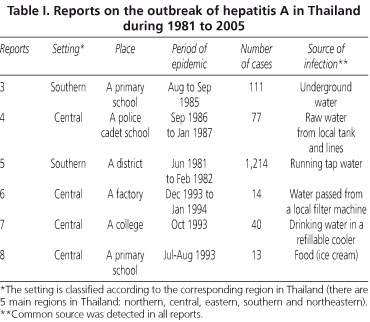Mi SciELO
Servicios Personalizados
Revista
Articulo
Indicadores
-
 Citado por SciELO
Citado por SciELO -
 Accesos
Accesos
Links relacionados
-
 Citado por Google
Citado por Google -
 Similares en
SciELO
Similares en
SciELO -
 Similares en Google
Similares en Google
Compartir
Revista Española de Enfermedades Digestivas
versión impresa ISSN 1130-0108
Rev. esp. enferm. dig. vol.100 no.2 Madrid feb. 2008
CARTAS AL DIRECTOR
Hepatitis A outbreak in Thailand during the past 25-year period: A summary
Epidemias de hepatitis A en Tailandia durante los últimos 25 años: un resumen
Palabras clave: Virus de la hepatitis A. Agua contmainada.
Key words: Hepatitis A virus. Contaminated water.
Dear Editor:
The hepatitis A virus (HAV), a picornavirus, is a common cause of hepatitis worldwide.
Hepatitis A remains an important cause of community-acquired hepatitis. Spread of infection is generally person to person or by oral intake after fecal contamination of skin or mucous membranes; less commonly, there is fecal contamination of food or water. Hepatitis A is endemic in developing countries, and most residents are exposed in childhood. In contrast, the adult population in developed countries demonstrate falling rates of exposure with improvements in hygiene and sanitation (1). Presently, many tropical countries are classified as endemic area for viral hepatitis A. In Thailand, hepatitis A infection is still an important viral infectious disease. A recent study indicated that up to 97% of the Thai adults had natural immunity to this disease (2). There have been sporadic reports on the outbreak of this infection for years.
Here, the authors performed a summarization on the previous reports on the outbreak of hepatitis A infection in a 25 years period, from 1980 to 2005. A literature review to find the reports on outbreak of hepatitis A in during that period in Thailand was performed. The author used the electronic search engine PubMed (www.pubmed.com) in searching for the literatures. The author also reviewed the published works in all 256 local Thai journals, which is not included in the international citation index by the database Thai Index Medicus. According to this study, there are at least 6 reports (3-8) on the outbreak of hepatitis A during 1980 to 2005 (Table I). There had been continuous reports on sporadic hepatitis A outbreak in Thailand during 1980's and early 1990's. However, there was no report after 1993. The numbers of reported cases in the outbreak range from 13 to 1,214 cases. The settings of outbreaks can be found in many settings, especially in schools (4/6 reports). The period of epidemic usually occurred in 1-2 months, with the common starting point in the rainy season of Thailand. The common sources of infections are water in 5 reports and food in 1 report.
According to this study, there is a trend of decrease report of hepatitis A outbreak in the last decade. This finding might imply the improvement in health education and control of this hepatitis disease in Thailand. Concerning the reported outbreak in this study, there are both reports of the outbreak among the children and adults. In this study, water is the main source of infection. Untreated contaminated drinking water is common (3,4,6). It seems that treated running tap water is important in prevention of hepatitis outbreak (9). However, well treated drinking water but later contaminated due to sharing cup can be seen (7). Therefore, the self-sanitation in drinking is important. Similar to many reports, the school is a common place for the outbreak of hepatitis A. Although there is an idea to provide hepatitis A vaccination to the school-aged children the cost effectiveness analysis of hepatitis A vaccination in Thailand show that it is not cost effective (10). Of interest, a large outbreak, with more than 1,000 infected cases, can be detected (5). The main root cause of this outbreak is due to the contamination of running tap water (5), which can affect to larger population than the local water sources in other reports (3,4,6-8). The author hereby concludes that provision of clean water and control of possible contamination in drinking water as well as eating and drinking sanitation are still the heart of infectious control for hepatitis A infection.
V. Wiwanitkit
Department of Laboratory Medicine. Faculty of Medicine. Chulalongkorn University. Bangkok, Thailand
References
1. Cuthbert JA. Hepatitis A: Old and new. Clin Microbiol Rev 2001; 14: 38-58
2. Kemmer NM, Burke DS, Snitbhan R, Johnson DE, Scott RM. Age-specific prevalence of hepatitis A virus antibody in Thailand. Am J Epidemiol 1981; 113: 245-9.
3. Pathanapornpandh N, Paisalsilp S, Patchakkhapat K. Hepatitis A outbreak in a primary school, Suratthani. Commun Dis J 1986; 12: 360-78.
4. Watanasi S, Oonhalekhaka A, Kaewnokkhao W, Khongket K, Chatsanga C, Toraksa K, et al. An epidemic of viral hepatitis A in the Police Cadet Academy. Thai Pol Med J 1987; 13: 205-22.
5. Phonboon K, Kasitipradit N, Lilapongse W, Paopradit M, Mobnarin S, Lailang W, et al. Hepatitis outbreak due to municipal piped water in Tungsong, Nakhon Si Thammarat. Commun Dis J 1984; 10: 14-36.
6. Siriarayaporn P, Sae-Jeng K, Phunawakul U, Chittrapitaklerd S, Chuthasmith K, Peerapattanapokin V, et al. A report on epidemiology surveillance of hepatitis A epidemic in a factory in Yannawa district, Bangkok. Month Epidemiol Surveil Rep 1994; 3: 693-6, 703-5.
7. Phunawakool U, Warintharawart S, Sanitpunt R, Chaikhun W. Outbreak of hepatitis A in Saraburi Province, October 1992. W Epidemiol Surveil Rep 1993; 24: 621-2, 629-31.
8. Rungsin R, Punnachet K, Peerapattanapokin V, Chitpitaklerd S, Siriarayaporn P, Thammapornpilard P, et al. Results from epidemiology surveillance of hepatitis A epidemic in "Soongsumarnwit" Bangparma school during 2-3 September, 1993. W Epidemiol Surveil Rep 1995; 26: 373-6, 383-7.
9. Appleton H. Control of food-borne viruses. Br Med Bull 2000; 56: 172-83.
10. Soogarun S, Wiwanitkit V. Vaccinating Thai adolescents against hepatitis A: Is it costeffective? Southeast Asian J Trop Med Public Health 2002; 33 (Supl. 3): 145-8.















